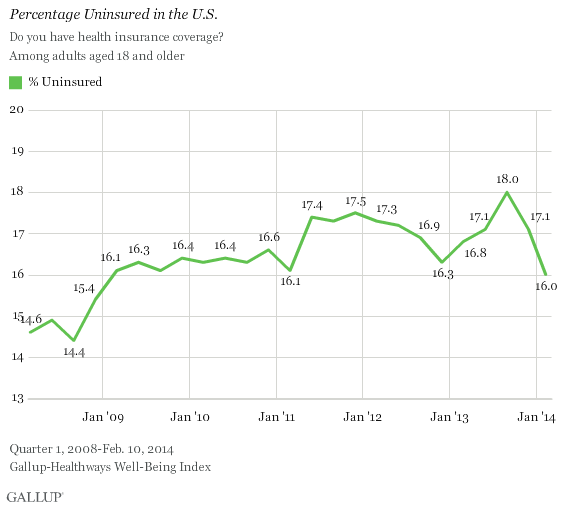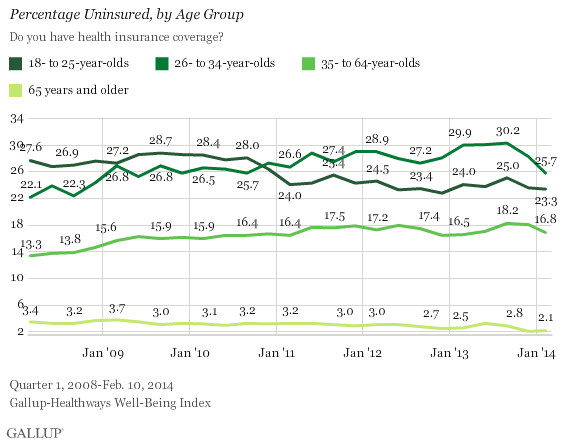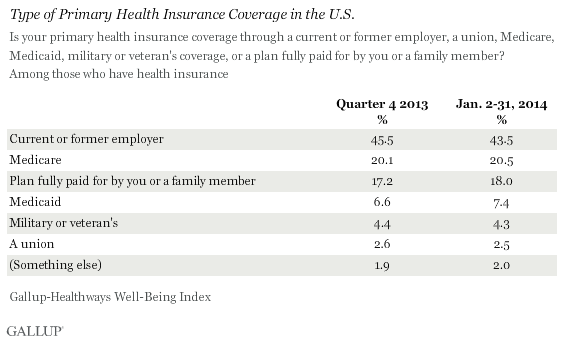WASHINGTON, D.C. -- The percentage of uninsured Americans fell to 16.0% so far in the first quarter of 2014 from 17.1% in the fourth quarter of 2013.

These data are based on more than 19,000 interviews with Americans from Jan. 2-Feb. 10, 2014, as part of the Gallup-Healthways Well-Being Index. While more than a month remains in the first quarter, these preliminary data show the uninsured rate appears to be on track to drop to the lowest quarterly level measured since 2008.
The uninsured rate also dropped to the low-16% range in late 2012 before rising again in 2013, suggesting that there may be inherent variability in the rate or random fluctuation due to sampling error. Still, if the uninsured rate continues to fall over the next several months, it may suggest that the Affordable Care Act's requirement for most Americans to have health insurance, which took effect on Jan. 1, is responsible for the decline.
Percentage of Uninsured 26- to 34-Year-Olds Continues to Fall
The percentage of uninsured 26- to 34-year-olds, which has been dropping since the third quarter of 2013, is now 25.7%. Americans in this age group have had the highest uninsured rate since 2011. The uninsured rate among 26- to 34-year-olds has been declining faster than it has among any other age group.
The uninsured rate among 18- to 25-year-olds declined slightly so far in 2014 to 23.3%. The uninsured rate for this age group has generally been steady since December 2010, after the Affordable Care Act provision allowing young adults under age 26 to remain on their parents' health insurance plans took effect. Prior to that provision's implementation, 18- to 25-year-olds were the most likely to lack health insurance among all age groups.

More Americans Have Medicaid, Fewer Are Covered Through Employers
The percentage of Americans who report they are insured through Medicaid has increased to 7.4% from 6.6% in the fourth quarter of 2013. This uptick may be because some states have chosen to participate in the Medicaid expansion under a provision of the Affordable Care Act.
Meanwhile, fewer Americans now say they get their primary insurance through a current or former employer -- 43.5% down from 45.5% in the fourth quarter of 2013. More Americans now say they have a plan fully paid for by themselves or a family member -- 18.0% versus 17.2% at the end of last year.

Implications
The percentage of uninsured Americans has marginally decreased since the requirement to have health insurance went into effect at the beginning of 2014. It remains unclear if this decline is an effect of the Affordable Care Act, or if the percentage who lack health insurance coverage is decreasing for other reasons.
Even though the uninsured rate is falling more rapidly among 26- to 34-year-olds than it is among other age groups, these young adults still remain the most uninsured age group. Perhaps this is because 26- to 34-year-olds do not have the option to remain on their parents' insurance plans that those under age 26 have.
The Obama administration and other proponents of the healthcare law have continued their appeal to younger Americans to sign up for health insurance through the exchanges established for the Affordable Care Act. Young Americans are critical to the success of the healthcare law; the White House previously said 40% of new health insurance enrollees would need to be younger adults. Young adults' premiums would help subsidize the cost of healthcare for older enrollees who tend to have more health problems.
Some provisions of the healthcare law have yet to take effect, such as the requirement that employers provide health insurance coverage to their workers by 2015 or 2016. These provisions will likely affect the percentage of Americans who are uninsured, as well as the type of insurance that Americans have.
Gallup will continue to track the U.S. uninsured rate in the weeks and months ahead.
About the Gallup-Healthways Well-Being Index
The Gallup-Healthways Well-Being Index tracks well-being in the U.S. and provides best-in-class solutions for a healthier world. To learn more, please visit well-beingindex.com.
Survey Methods
Results are based on telephone interviews conducted as part of the Gallup-Healthways Well-Being Index survey Jan. 2-Feb. 10, 2014, with a random sample of 19,293 adults, aged 18 and older, living in all 50 U.S. states and the District of Columbia.
For results based on the total sample of national adults, the margin of sampling error is ±1 percentage points at the 95% confidence level.
Interviews are conducted with respondents on landline telephones and cellular phones, with interviews conducted in Spanish for respondents who are primarily Spanish-speaking. Each sample of national adults includes a minimum quota of 50% cellphone respondents and 50% landline respondents, with additional minimum quotas by region. Landline telephone numbers are chosen at random among listed telephone numbers. Cellphone numbers are selected using random-digit-dial methods. Landline respondents are chosen at random within each household on the basis of which member had the most recent birthday.
Samples are weighted to correct for unequal selection probability, nonresponse, and double coverage of landline and cell users in the two sampling frames. They are also weighted to match the national demographics of gender, age, race, Hispanic ethnicity, education, region, population density, and phone status (cellphone only/landline only/both, cellphone mostly, and having an unlisted landline number). Demographic weighting targets are based on the most recent Current Population Survey figures for the aged 18 and older U.S. population. Phone status targets are based on the most recent National Health Interview Survey. Population density targets are based on the most recent U.S. census. All reported margins of sampling error include the computed design effects for weighting.
In addition to sampling error, question wording and practical difficulties in conducting surveys can introduce error or bias into the findings of public opinion polls.
For more details on Gallup's polling methodology, visit www.gallup.com.
